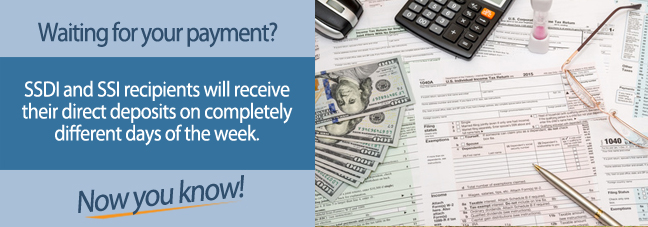If you or your child are suffering a disability, you may be eligible for help from the Social Security Administration. There are 2 programs under the SSA that are meant for the disabled, and they are Social Security Disability Insurance (SSDI) and Supplemental Security Income (SSI).
SSDI benefits are an entitlement available to those disabled who have earned work credits by being in the workforce for 10 years and made contributions to FICA, only for adults.
SSI is intended to help low-income disabled with extra money for food and shelter, and disabled children could qualify for these payments. You must have a very low income and few assets to qualify for SSI benefits.
Similarities Between SSDI and SSI
SSDI and SSI have a lot in common. They are both Social Security Administration programs, and they both require that you meet the SSA’s criteria for disability. However, they differ in size of payments you can receive, and when you’ll receive your payments.
SSDI and SSI differ in how much you can receive in benefits. Because SSDI benefits are based on your earning record and not your income, the amount of payment varies from person to person. People with disabilities can receive much bigger payments from SSDI than from SSI.
SSI benefits are strictly limited. The most you can receive in SSI benefits, or the FBR (Federal Benefit Rate), in 2025, is $967 per month. However, many states offer a small supplementary benefit as well, which is helpful.
SSI Payment Dates
It can be confusing trying to figure out when your benefits will be paid. With SSI payments, it’s simple, because you will be paid on the 1st of each month after your application. If the 1st falls on a Saturday, Sunday, or a federal holiday, you will be paid on the business day before then. For example, if the 1st on the month falls on a Saturday, you’ll receive your benefits the Friday before.
Most recipients of SSI payments prefer to receive their funds online via direct deposit, or the Direct Express card program, but if your funds are mailed to you, they may be a couple days late. The SSA asks that you not contact them about lost checks until the fourth day after the first of the month.

SSDI Payment Dates
With SSDI payments, it’s another story. The date of your benefit is determined by your birthday, and there are 3 brackets.
- If your birthday falls between the 1st and 10th of the month, you’ll receive SSDI benefits on the 2nd Wednesday of every month.
- If your birthday falls between the 11th and 20th of the month, your benefits will come the 3rd Wednesday of every month.
- If your birthday falls between the 21st and the last day of the month, your payments will come on the 4th Wednesday of every month.
These SSDI benefits are paid on accrual, meaning the benefits you receive for one month equals the amount owed for the month before.
If you are eligible for SSI and SSDI benefits, and receive them in one payment, the date of payment will be the 3rd day of every month.
Social Security Disability Benefits Pay Chart
In 2025, Social Security disability benefits will increase by 2.5% based on the cost of living adjustment. Below is the Social Security disability benefits pay chart in which individuals on SSDI and SSI can see what they can expect their benefits to increase the following year.
| Recipient | 2024 Amount | 2025 Amount |
|---|---|---|
| SSI Indivudal | $943 | $967 |
| SSI Couple | $1,415 | $1,450 |
| SSDI Individual | $1,537 | $1,580 |
Qualifying For SSI vs. SSDI
If you currently are not receiving disability benefits, you may be wondering what the differences are between SSI and SSDI. Both have the same medical requirements to qualify. The difference between the SSI and SSDI is the non-medical requirements. SSDI requires a specific amount of work credits while SSI has set income limits and does not have any work credit requirements.

SSDI
To qualify for SSDI, you will need to have enough work credits. Work credits are earned by working and paying into Social Security taxes. In 2025, you will need to have earned $1,810 to earn one work credit. The number of work credits required to qualify for SSDI varies by age. For example, if you are 46, you will need to have earned at least 24 work credits while someone who is 56 will need about 34 work credits. Typically, if you have worked 5 of the last 10 years, you will have enough work credits.
SSI
SSI does not require a specific amount of work credits. Instead, SSI is meant for those with extreme financial needs. This means you will need to meet specific income restrictions to qualify. The income limits are by household, so your spouse’s income and assets may impact eligibility. A family’s combined income must be less than $3,000 in income and assets. If you are unmarried, then your combined income and assets must be under $2,000.
Medical Requirements
Both SSI and SSDI have the same medical requirements. To medically qualify for disability benefits, you will need to prove that you meet a Blue Book listing. The Blue Book is the set of medical criteria that the SSA uses to evaluate your claim. There are hundreds of listings within the Blue Book. Each listing explains the medical criteria for that condition as well as the medical evidence you will need to support your claim. This includes things like test results, x-rays, treatment plans, etc.
When applying, it’s best to look over the Blue Book with your doctor. If you are missing some of the information needed to prove you medically qualify, then your doctor can help orchestrate these tests.

Help Applying For SSI or SSDI
When applying for SSDI and SSI benefits, it’s wise to consult a disability attorney. The attorney can help you optimize the benefits you receive, and appeal any denied claims, as well as guide you through the application process.
